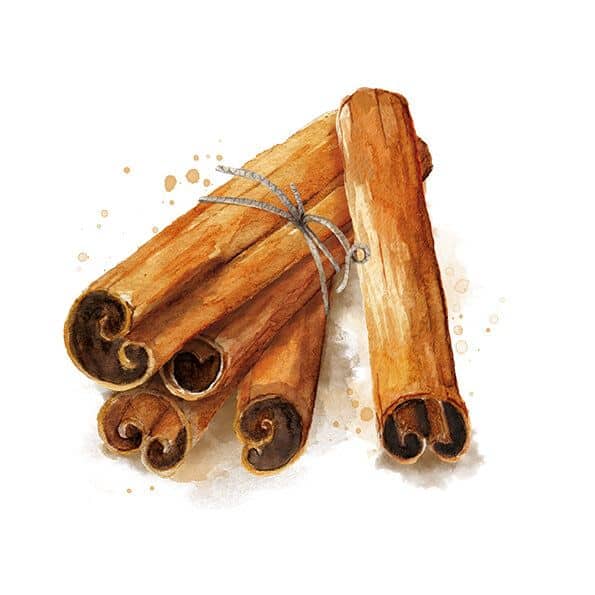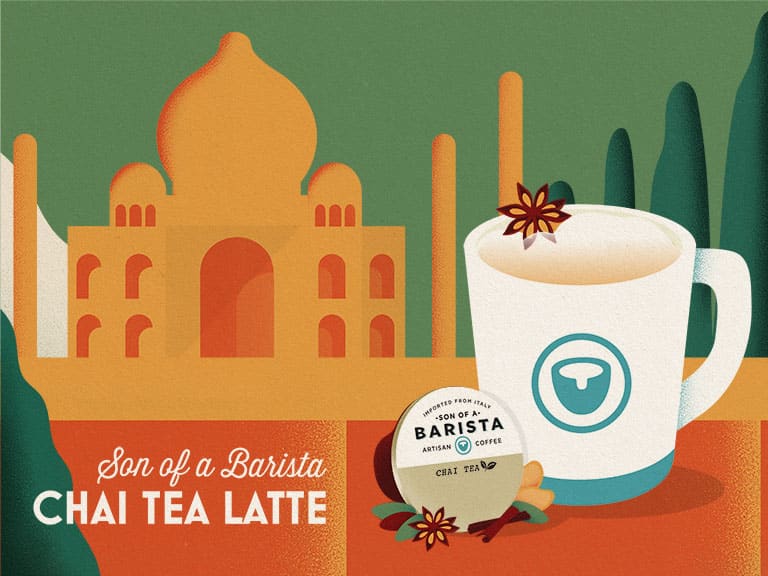Chai tea and its different recipes
Chai is a way of life in India. Almost everywhere you go—in trains, on streets, in sari shops—you will see people gulping down the sweet, spicy, milky beverage. It is their equivalent to the espresso in Italy, and frankly, we wanted in on the good stuff.
In America, “chai” has become known as a flavor of tea with predominantly cinnamon or cardamom notes. But in India, chai is not a flavor of tea; it is tea—chai literally translates to “tea” in Hindi, so when you are saying “chai tea,” you are basically saying, “tea tea.” Please don’t say tea tea.
Chai tea has taken America, and Italy, by storm. And we Italians have adapted the Indian beverage to make it our own.
In this Son of a Barista guide we’ll take you from the beginnings of chai tea to present day. We’ll guide you through the origins of chai tea, the health benefits of chai tea, cool, new, modern day versions of chai tea with Italian influences, and how to make it at home.
Origin of chai tea
Legend has it that the origin of chai dates back more than 5,000 years, when a king in what is now India ordered a healing spiced beverage he created for use in Ayurveda, a traditional medicinal practice in which herbs and spices are used for healing. The heat from ginger and black pepper was believed to stimulate digestion; the antiseptic properties in cloves were thought to help relieve pain; cardamom was used as a mood elevator; cinnamon supported circulation and respiratory function; and star anise was known to freshen the breath.
As the healing beverage spread across India a wide variety of spices were used to prepare the drink, depending on the region of the continent, or even the neighborhood, where the beverage was being made. Believe it or not, original versions of “masala chai”, or “spiced tea”, contained no actual Camellia sinensis tea leaves. Milk and sugar were also later additions to the famous drink.
The addition of black tea leaves, milk, and sugar were popularized thousands of years later (in the mid-1800s) when the Camellia sinensis assamica tea plant variety was discovered in India and cultivated by the British.
What is chai tea
Chai is steeped in a rich history. The name “chai” is actually the Hindi word for “tea”, which was derived from “cha”, the Chinese word for “tea”. In this case, the Hindi term chai means a mix of spices steeped into a tea-like beverage. Recipes for chai vary across continents, cultures, towns and families. But the traditional ingredients of a spiced tea blend usually include black tea mixed with strong spices, like cinnamon, cardamom, cloves, ginger and black peppercorns. The spiced tea mixture is typically brewed strong with milk and sweetened with sugar or honey. However, the milky sweet tea treat we order in coffee and tea shops today has very little in common with the origins of Indian chai.
The tea
The base of chai is a black tea. There are many variations of black tea, but Assam is the most common in chai, as it has a strong, full-bodied flavor.
The spices
Chai can include a number of different spices. Cardamom is the most common ingredient, followed by some mixture of cinnamon, ginger, star anise, and cloves. Pepper, coriander, nutmeg and fennel are also used, but they are slightly less common.
The milk
Chai almost always includes milk, and that milk is usually whole. This is because whole milk is the best way to bring out the richness in all the spices.
The sweetener
Plain white sugar is the most common sweetener for chai. Jaggery, or unrefined cane sugar, is also used, due to its concentrated sweet flavor, but it’s harder to find in America.

Health benefits
As you can see all these flavors are super soothing and blend together spiciness with sweetness. It’s thanks to these delicious spices (and the black tea base) that add up to chai being a high-quality drink that brims with health benefits. Many of these spices are used in traditional Chinese medicine and Indian ayurvedic medicine too.
The black tea in chai is rich in antioxidants and the spices in chai have been used for thousands of years to promote general health and well-being, as well as to treat various ailments.
According to Ayurvedic (Ancient Indian) philosophy and medicine, these spices are considered to be “sattvic,” or calming, vitalizing and mentally clarifying – the perfect antidote to the stresses of modern life!
We take a look at all the amazing ways that chai can bring its healing goodness to your cup.
Antioxidants
Chai is ripe with powerful antioxidant properties that come not only from the polyphenols found in tea but also the spices too. Black tea (the base of chai) helps to protect cells from free radicals which can lead to everything from cancer to the signs of ageing. Specifically, Indian black teas, like the ones in Son of a Barista’s chai tea, have been studied, and it has been found that they contain some of the highest antioxidant properties out of all the different types of tea. Combine that with a blend that has cardamom – a spice also rich in antioxidants and you have a healing brew that will definitely do!
Weight loss
The melody of black tea and carefully chosen spices are also believed to assist with healthy weight loss plans. Black tea is already known for helping the body burn fat and encouraging a lesser calorie count. When blended with cinnamon, this spice is known for a whole host of properties that can help with weight loss – from reducing cholesterol to dealing with blood sugar levels. But most of all, it seems that the studies show that cinnamon may be able to boost your metabolism, which means you can turn calories into energy quicker.
Heart health
In order to tick like clockwork our hearts rely on healthy blood pressure levels along with solid and safe cholesterol levels too. Fortunately, chai tea can set you on the straight and narrow when it comes to heart health. Cardamom is said to be a heart healer and cinnamon can help to regulate blood sugar levels and studies have shown that this spice can lead to a healthy heart. Black tea comes with superhero properties for your cardiovascular health too. Black tea also works by lowering bad cholesterol which gives your heart a fighting chance at staying fit and healthy.
Anti-inflammatory
Whether dealing with something as simple as toothache or more complicated chronic pain issues, chai can help to reduce those aches and pains. This special brew is chock full of spices that are loaded with anti-inflammatory properties – ginger for increasing circulation which can send oxygen heavy red blood cells where they are needed and black tea can also help reduce inflammation as studies have shown. From Alzheimer’s disease to arthritis, reducing inflammation in the body can help with a whole range of ailments.
Immune system
Give your immune system a mighty boost as you nurse a steaming cup of sweet chai tea. Not only does black tea boost your immunity but the wild array of spices are fat with immune boosting properties. Ginger is one of the best things for your gut and when you have a healthy gut you are more than ready to fend off colds and other viruses. Cardamom is also loaded with vitamin C and a whole host of other immune boosting properties that keep you well protected.
Boosts energy
Chai actually contains more caffeine in it than the regular black tea as it tends to be made from CTC types of tea leaf which have a higher caffeine count. While chai certainly won’t be in the same caffeine rich camp as coffee, it does have enough caffeine in it to wake you up and bring a boost to those who are slumping into fatigue. Whether you make your chai tea as a morning pick-me-up or to pull you out of an afternoon work slump, this heady concoction is sure to have you on your feet.
Stress relief
Looking for a natural stress buster? Here we have yet another natural reason to brew up a cup of chai tea. Tea is always a soothing routine that invites you to take a mindful moment and to reconnect with your own needs. When blended with the bounty of fragrant spices like soothing cloves, ginger, and cardamom you have a stress balancing formula that will instantly soothe the nerves.

Dirty chai tea
Chai-flavored foods and drinks have become incredibly popular in recent years, and dirty chai is a great alternative for those who don’t love the taste of strong coffee but wish to indulge anyways.
Dirty chai is a latte drink that contains a single shot or double shot (doppio) of espresso, steamed milk, and spiced black tea. It is smooth and milky, fragrantly spiced, with a mild coffee flavor. For more coffee strength, an extra shot of espresso can be added.
How to make a dirty chai tea
For your convenience, Son of a Barista has made it easy for you to enjoy a delicious dirty chai tea without the hassle of mixing espresso, steamed milk and spiced black tea together. Simply get a perfect dirty chai tea in two presses of a button on our Son of a Baritsa coffee machine.
- First, insert your desired espresso pod into the Son of a Barista coffee machine. Press the small button for a single shot of espresso or the big button for that extra caffeine kick that you’ll get from a double shot of espresso.
- Second, insert the Son of a Barista chai tea pod into the Son of a Barista coffee machine. Hold down the small or large button for as long as you’d like your dirty chai to be.
- Third, enjoy a steaming hot dirty chai in the comfort of your own home.
Caffeine content in dirty chai tea
Dirty chai latte packs a double whammy of caffeine from the black tea, and a shot or two of espresso. The average caffeine level of a 12-ounce dirty chai latte is 160 milligrams (versus 50 to 70 milligrams for a chai latte).
Iced dirty chai tea
If you’re not in the mood for a hot beverage, try an iced dirty chai to cool you down while at the same time keeping you caffeinated! An iced dirty chai includes ice and can be enjoyed in the form of an iced latte or a blended latte.




